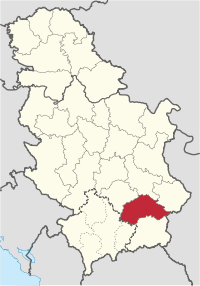Jablanica District
Jablanica District
Јабланички округ Jablanički okrug | |
|---|---|
|
Images from the Jablanica District | |
 Location of the Jablanica District within Serbia | |
| Coordinates: 43°00′N 21°57′E / 43.000°N 21.950°E | |
| Country | |
| Region | Southern and Eastern Serbia |
| Administrative center | Leskovac |
| Government | |
| • Commissioner | Božidar Stojiljković |
| Area | |
| • Total | 2,769 km2 (1,069 sq mi) |
| Population (2022 census)[1] | |
| • Total | 184,502 |
| • Density | 67/km2 (170/sq mi) |
| ISO 3166 code | RS-23 |
| Municipalities | 5 and 1 city |
| Settlements | 336 |
| – Cities and towns | 7 |
| – Villages | 329 |
| Website | jablanicki |
The Jablanica District (Serbian: Јабланички округ, romanized: Jablanički okrug, pronounced [jâblaːnitʃkiː ôkruːɡ]) is one of nine administrative districts of Southern and Eastern Serbia. It expands in the south-eastern parts of Serbia. As of 2022 census, the district has a population of 184,502 inhabitants.[1] The administrative center of the district is the city of Leskovac.
Municipalities[edit]
The district encompasses the municipalities of:
Demographics[edit]
| Year | Pop. | ±% |
|---|---|---|
| 1948 | 231,280 | — |
| 1953 | 244,128 | +5.6% |
| 1961 | 254,855 | +4.4% |
| 1971 | 260,982 | +2.4% |
| 1981 | 262,531 | +0.6% |
| 1991 | 255,011 | −2.9% |
| 2002 | 240,923 | −5.5% |
| 2011 | 216,304 | −10.2% |
| 2022 | 184,502 | −14.7% |
| Source: [2] | ||
As of 2022 census, the district has a population of 184,502 inhabitants.[1]
Ethnic groups[edit]
Ethnic composition of the Jablanica District (per 2011 and 2022 censuses):
| Ethnic group | Census 2011 | Census 2022 | ||
|---|---|---|---|---|
| Population | % | Population | % | |
| Serbs | 199,901 | 92.4 | 164,382 | 89.1 |
| Romani | 11,436 | 5.29 | 10,542 | 5.71 |
| Albanians | 548 | 0.25 | 928 | 0.50 |
| Montenegrins | 386 | 0.18 | 184 | 0.10 |
| Macedonians | 354 | 0.16 | 249 | 0.13 |
| Bulgarians | 107 | 0.05 | 107 | 0.06 |
| Yugoslavs | 96 | 0.04 | 143 | 0.08 |
| Others | 3,476 | 1.61 | 7,967 | 4.32 |
| Total | 216,304 | 184,502 | ||
History and culture[edit]
Famous cultural-historic monuments in this District are: the Roman necropolis in Mala Kopasnica originating from 2nd century AD, a late Roman-early Byzantine (6th century AD) town of Caričin Grad or Iustiniana Prima, the Jašunja Monasteries dedicated to the Virgin of Transfiguration and St. John the Baptist, built in 1499 as the endowment of monastery sister Ksenija, as well as the church of St. John the Baptist from 16th century, being a true pearl among monuments.
See also[edit]
Notes[edit]
References[edit]
- ^ a b c "Prvi rezultati Popisa stanovništva, domaćinstava i stanova 2022". stat.gov.rs (in Serbian). 21 December 2022. Retrieved 16 February 2023.
d
- ^ "2011 Census of Population, Households and Dwellings in the Republic of Serbia" (PDF). stat.gov.rs. Statistical Office of the Republic of Serbia. Retrieved 12 January 2017.
Note: All official material made by the Government of Serbia is public by law. Information was taken from the official website.













